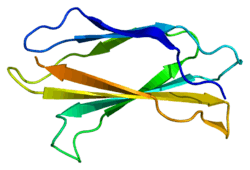Beta-sandwich

β-sandwich domains consisting of 80 to 350 amino acids occur commonly in proteins. They are characterized by two opposing antiparallel β-sheets.[1] The number of strands found in such domains may differ from one protein to another. β-sandwich domains are subdivided in a variety of different folds. The immunoglobulin-type fold found in antibodies (Ig-fold) consists of a sandwich arrangement of 7 and 9 antiparallel β-strands arranged in two β-sheets with a Greek-key topology. The Greek-key topology is also found in Human Transthyretin. The jelly-roll topology is found in carbohydrate binding proteins such as concanavalin A and various lectins, in the collagen binding domain of Staphylococcus aureus Adhesin and in modules that bind fibronectin as found in Tenascin (Third Fibronectin Type III Repeat). The L-type lectin domain is a variation of the jelly roll fold. The C2 domain in its typical version (PKC-C2) is a β-sandwich composed of 8 β-strands.
References
- ↑ Kister, A. E.; Fokas, A. S.; Papatheodorou, T. S.; Gelfand, I. M. (2006). "Strict rules determine arrangements of strands in sandwich proteins". PNAS. 103 (11): 4107–4110. doi:10.1073/pnas.0510747103. PMC 1449654. PMID 16537492.